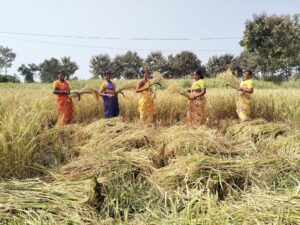
The publication in 2005 of the rice genome—the sum total of genetic information in the rice plant, encoded in its DNA—provided a huge boost to genetic research. But, as we try to find genetic answers to questions such as why one variety tastes delicious but another tastes mediocre, we fall into that dark space between genotype and phenotype—that is, the unknown processes at the subcellular level that are regulated by the genes, and that lead to the end result that humans can see, feel, and of course taste.
That dark and seemingly impenetrable gap is buzzing with chemicals and reactions. It is the place where a chemical compound or compounds can switch on a gene, link an amino acid onto a growing protein, connect a glucose molecule to a growing chain of starch, or join together to make the key aromatic compound in fragrant rice. These processes, which are regulated or carried out in families of reactions, involve tens of thousands of small chemicals and compounds known as metabolites, many of which chemists have never seen. The detection, identification, and quantification of these small compounds are the elements of a new science called metabolomics. Some of the small compounds dissolve in solutions and some are volatile. These features determine the equipment that can be used, or that needs to be developed, to identify and measure them.
For a person involved in unravelling the science of the traits of rice quality, an obvious application for metabolomics is to try to solve some of the mysteries of aroma. Even Westerners who don’t grow up eating rice can discriminate between the taste of Thai jasmine and Indian/Pakistani basmati rice. Asians who eat rice from the moment they can manage solid food, on the other hand, can discriminate between basmati grown in the Punjab and basmati grown 50 km away, and between jasmine rice grown in different regions of Thailand. Besides jasmine and basmati, well-trained palates can discriminate between the many, many more aromatic rice varieties grown in Southeast, South, and Central Asia.
Scientists have found a gene for aroma, which is carried by both jasmine- and basmati-style rice varieties. However, science has not yet discovered what determines the difference in taste between jasmine and basmati, let alone geographic and seasonal effects on the taste. Presumably, jasmine and basmati rice have unique chemical signatures, and metabolomics should be the conduit to knowing and understanding those signatures. In this way, we hope to close the gap between the genes and the suite of compounds that interact to make what we detect as taste.

Rice researchers have not yet succeeded in developing new varieties with higher yield while still maintaining aromatic quality. Examples of this can be found all over Asia. Take the highly prized, traditional Thai jasmine variety, Khao Dawk Mali 105 (KDML105). The aroma of KDML105 is renowned around the world, and many Southeast Asian rice breeders have used the variety in breeding programs that aim to obtain higher-yielding or disease-resistant forms of the rice.
In one case, genes for resistance to the devastating blast fungus were incorporated into KDML105 through traditional breeding. In three studies, the blast-resistant form of KDML105 had less than half of the key aromatic compound, 2-acetyl-1-pyrroline (2AP), contained in KDML105 itself.
In another study at IRRI, a number of varieties developed from crosses with KDML105, and that had obtained the same fragrance gene, all contained less 2AP than KDML105. Why is aroma best in KDML105? This is the sort of question, lurking in the dark space between genes and taste, that perplexes breeders and cereal chemists, and disappoints rice farmers, rice consumers, and rice traders.
But are such questions still unanswerable? Metabolomics could be the torch that illuminates that darkness, thus enabling us to find some of the compounds that explain variability in taste. IRRI is a collaborator in the METAPHOR project, funded by the European Union, to develop and standardize methods for metabolomic profiling of plants, and to develop a database of soluble and volatile plant metabolites (see www.metaphor.eu for more information).
The International Network for Quality Rice (INQR) has provided a platform for national rice research organizations interested in aroma to collaborate with the META-PHOR project. Network members from Thailand, Laos, Vietnam, Malaysia, the Philippines, Myanmar, Indonesia, Australia, Pakistan, India, and Iran have supplied a total of 32 of their highest-quality aromatic rice varieties to the META-PHOR scientists. Of the 32 varieties, 21 are traditional, five have fragrance from KDML105, and six carry fragrance from other traditional varieties.
This initiative is giving scientists a real chance to do four key things: determine the difference between jasmine and basmati rice, identify the key compounds that differentiate the different types of aromatic rice, determine how many different types of aromatic signatures there are, and develop a library of compounds to measure in the development of new aromatic varieties. This knowledge will put scientists in position to not only understand the fundamental biochemical basis of aroma in rice but also to formulate targeted strategies for improving such traits of quality.
The metabolomic profilers plan to shine their torches at a joint META-PHOR–INQR meeting in Laos in May 2008. They will report on their answers to the questions raised in this article and show their colleagues from national and international research organizations some of the compounds and reactions that lie in that dark space between the genotype and phenotype of these aromatic rice varieties.








